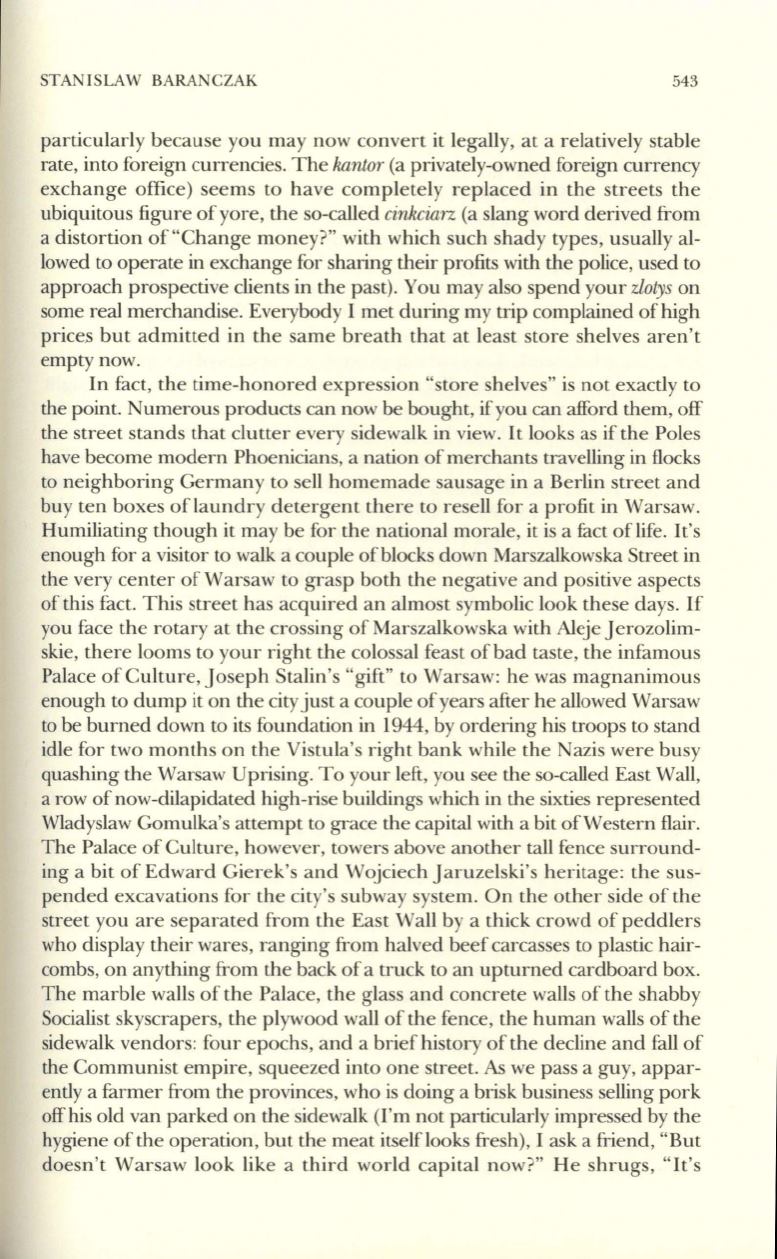
STANISLAW BARANCZAK
543
particularly because you may now convert it legally, at a relatively stable
rate, into foreign currencies. The
kantor
(a privately-owned foreign currency
exchange office) seems to have completely replaced in the streets the
ubiquitous figure of yore, the so-called
cinkciarz
(a slang word derived from
a distortion of "Change money?" with which such shady types, usually al–
lowed to operate in exchange for sharing their profits with the police, used to
approach prospective clients in the past). You may also spend your
zlotys
on
some real merchandise. Everybody I met during my trip complained of high
prices but admitted in the same breath that at least store shelves aren't
empty now.
In fact, the time-honored expression "store shelves" is not exactly to
the point. Numerous products can now be bought,
if
you can afford them, off
the street stands that clutter every sidewalk in view. It looks as if the Poles
have become modern Phoenicians, a nation of merchants travelling in flocks
to neighboring Germany to sell homemade sausage in a Berlin street and
buy ten boxes oflaundry detergent there to resell for a profit in Warsaw.
Humiliating though it may be for the national morale, it is a fact of life. It's
enough for a visitor to walk a couple of blocks down Marszalkowska Street in
the very center of Warsaw to grasp both the negative and positive aspects
of this fact. This street has acquired an almost symbolic look these days. If
you face the rotary at the crossing of Marszalkowska with Aleje jerozolim–
skie, there looms to your right the colossal feast of bad taste, the infamous
Palace of Culture, joseph Stalin's "gift" to Warsaw: he was magnanimous
enough to dump it on the city just a couple of years after he allowed Warsaw
to be burned down to its foundation in 1944, by ordering his troops to stand
idle for two months on the Yistula's right bank while the azis were busy
quashing the Warsaw Uprising. To your left, you see the so-called East Wall,
a row of now-dilapidated high-rise buildings which in the sixties represented
Wladyslaw Gomulka's attempt to grace the capital with a bit ofWestern flair.
The Palace of Culture, however, towers above another tall fence surround–
ing a bit of Edward Gierek's and Wojciech jaruzelski's heritage: the sus–
pended excavations for the city's subway system. On the other side of the
street you are separated from the East Wall by a thick crowd of peddlers
who display their wares, ranging from halved beef carcasses to plastic hair–
combs, on anything from the back of a truck to an upturned cardboard box.
The marble walls of the Palace, the glass and concrete walls of the shabby
Socialist skyscrapers, the plywood wall of the fence, the human walls of the
sidewalk vendors: four epochs, and a brief history of the decline and fall of
the Communist empire, squeezed into one street.
As
we pass a guy, appar–
ently a farmer from the provinces, who is doing a brisk business sel1ing pork
off his old van parked on the sidewalk (I'm not particularly impressed by the
hygiene of the operation, but the meat itselflooks fresh), I ask a friend, "But
doesn't Warsaw look like a third world capital now?" He shrugs, "It's


